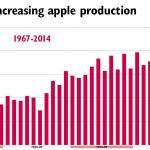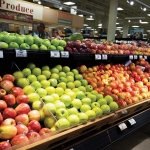John Rice made an important point when he spoke to growers at the International Fruit Tree Association winter meeting in Halifax, Nova Scotia, in February.
He read a list. It contained, in alphabetical order, the names of 54 new and club apple varieties consumers are being introduced to. The list started with Ambrosia and Ariane and ended with Zestar and Zonga.
Spice of life?
“I know variety is the spice of life, and there are probably some great apples in this list,” said Rice, who is vice president for sales at Rice Fruit Company in Gardners, Pennsylvania. “In fact, I know there are. But the thing that worries me as a marketer is knowing that most of this drive to plant and produce new varieties is producer-driven rather than consumer-driven. It is not driven by some pent up consumer demand that we are not currently fulfilling.
“The consumer did want something better than Red Delicious. Our industry came up with six or eight different varieties that were considerably better. The consumer is not asking for 50 more. And I can tell you that the major retailers are not asking for that many.”
Rice Fruit Company is a grower, packer, and marketer that supplies 3 million boxes of apples annually. Along with Columbia Marketing International in Washington and Applewood in Michigan, it co-manages Kiku, a branded Fuji sport.
The motivation behind growing club varieties is to achieve a premium price by growing a better apple and then carefully managing the quality by limiting the people who grow and pack it to a select few, he said. “With our managed Kiku brand, we have quite successfully maintained our quality and a premium price,” he said.
That price has not been as high as Honeycrisp in the past, but is well above the price of Red Delicious and Gala.
Rice doubts that any new variety is likely to overtake Honeycrisp at this point.
As people tried Honeycrisp, “an amazing number of people were totally converted—saying it was the only apple they ever expected to buy again,” he said.
Rice thinks that other amazing apples are possible and that the Kiku is one of them. He thinks that the fact that people have been willing to pay such high prices for Honeycrisp makes it more likely that they will pay a premium price for another amazing apple.
But, he says, there are probably not 54 ways for apples to be amazing and different at the same time. Many of the new ones, in fact, are spinoffs of Honeycrisp, varieties with a Honeycrisp parent. A lot of them are bicolored apples that look very much alike.
“When consumers chose Honeycrisp, they embraced a bicolored apple, but that doesn’t mean they prefer only bicolored apples,” Rice said. “In my opinion, an apple still needs to be aesthetically pleasing.”
Because Washington State was for many years able to produce such colorful Red Delicious with the prominent lobes that make it so distinctive, it became a model for what an apple should look like—and many consumers, especially in Asia, agree with that still. “It is very distinctive in shape and color, and there are reasons why it dominated the market for 50 years.”
What Rice sees for the future is a relative handful of new apples, probably club varieties, rising to the top and many others failing. He thinks the successful new apples will be marketed very intelligently—with advertising, samplings, and other inducements to get consumers to try something new.
Seven attributes
Rice lists seven attributes that he thinks a successful new variety should have.
1 “First it has to taste great, of course,” he said. “But not just great. It has to have a certain ‘wow’ factor, like the original Honeycrisp had for first-time consumers.” A unique Honeycrisp trait—strong cell walls that rupture with an explosion of juice and flavor—provides the “wow” factor for Honeycrisp. But different “wows” are needed for other varieties.
2 It must have enough visual appeal that a consumer would be inclined to pick it up with no other inducement. “After all, only farm markets have the opportunity to put an apple into a customer’s hand and say, ‘This apple may not look great, but the eating quality is fantastic.’
Personally I think we have taken the bicolored apple about as far as we can. I think we have enough bicolored apples now. I think breeders should be looking for pretty red and yellow and green apples again. I think that an important part of the appeal of any apple is that it is the most beautiful of all fruits.”
3 It must stay hard and crispy under normal storage conditions.
4 It has to provide a consistent consumer experience. It was inconsistency in eating quality that ultimately hurt Red Delicious.
5 It should crop well and consistently for the grower. It should have good production per acre, with high packouts. And very definitely, it should not bruise easily.
6 It must be naturally large. The preferred size for most American retailers is 80 or 72, which is almost 3.25 inches in diameter. Smaller apples, even Honeycrisp, are bagged and sold at a lower price per pound. Europeans seem to prefer a medium sized apple, but most Americans don’t, he said.
7 It must have a 12-month marketing season.
Ironically, Rice said, the two most popular apples in the United States do not necessarily pass these tests. For one thing, Honeycrisp bruises very easily. And both Gala and Honeycrisp lose flavor over time, and packouts go down late in the season.
Given the huge supply of apples that is building in the United States, Rice thinks we shouldn’t have to import apples from the Southern Hemisphere to maintain the high quality of our apple displays the way we do now. One possibility is that some new variety will find its niche by tasting great in the spring and summer marketing seasons.
“In my grandfather’s day, York Imperial was his most popular apple in this late season, but it was a rather ‘homely’ apple, and we do not grow them any longer for the fresh market.”
Rice thinks Kiku is sufficiently differentiated to do well in the upcoming fight for shelf space. “It is an extraordinary apple. We’ve never experienced a variety like it. It has the highest sugar levels of any apple we’ve ever grown. It can get as high as 20° Brix, and it is crisp and juicy.” It is a sure seller in Asian-American and other markets that love a sweet apple, he said. •








Leave A Comment